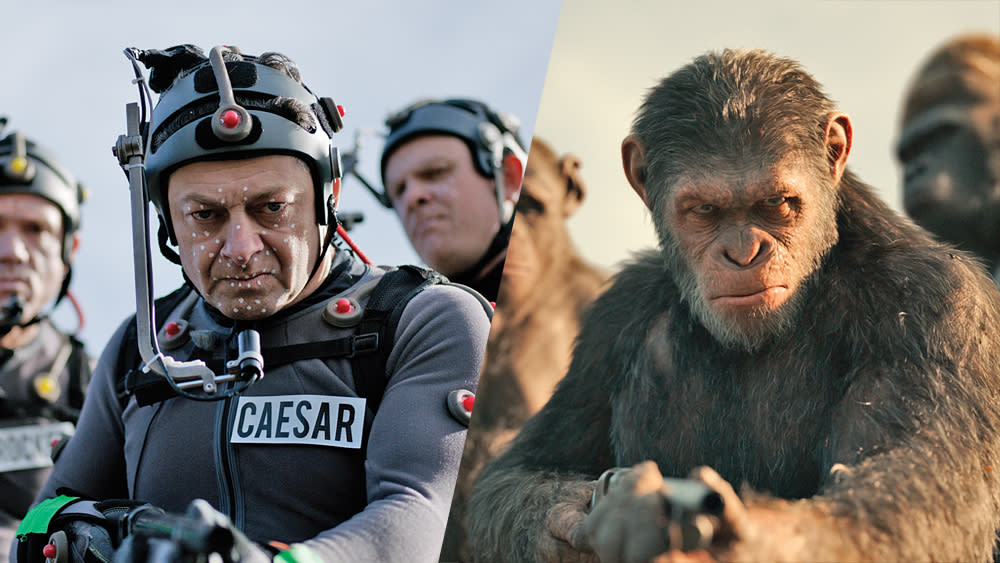Weta Digital Takes Third ‘Planet of the Apes’ VFX to a New Level

The 2011 “Rise of the Planet of the Apes” offered visual-effects breakthroughs, and the filmmakers raised the bar even higher in the 2014 sequel. The finale in the trilogy, 2017’s “War for the Planet of the Apes,” is the most ambitious and most effective yet, thanks to director Matt Reeves, who gives a lot of credit to Weta Digital: “These guys make the impossible happen.”
“War for the Planet of the Apes” is Oscar-nominated for its VFX work and on Feb. 13 led the Visual Effects Society Awards, with four trophies.
Reeves talked with Weta’s Joe Letteri and Dan Lemmon about “War” in a Q&A session at the Directors Guild in Hollywood Feb. 12. The film’s innovations include a spectacular avalanche, the enhancement of the many real locations (e.g., adding a key waterfall), an explosive helicopter battle, details like wet and/or snowy fur, and the creation of new characters like Bad Ape.
Their biggest challenge was subtle, but crucial: facial work on the multiple ape characters. The script by Reeves and Mark Bomback gave more depth to the characters than in the previous films, with greater introspection and conflicting emotions, often done in closeups.
Senior visual effects supervisor Letteri worked on all three movies and said, “In a way, with each film you start over again. We rebuilt everything with more details. In this film, there are a lot of inner monologues in tight closeups, and the changes in expression are very small. It takes a long time to get those details right.”
Visual effects supervisor Lemmon added, “In a sense, Matt directed the film twice: once with the actors on the set and once with us.” They spent a year in post-production, poring over each shot frame by frame, to make sure the digital work matches the emotions depicted by the cast, including actors Andy Serkis, Karin Konoval and Steve Zahn, who played Bad Ape.
Apes’ faces are not expressive in the same way as humans’ and they don’t move their mouths to form words. The goal was to add these factors without making the apes look too human. In this third film, Lemmon said, “We saw Andy doing things he’d never done in the other movies, and that motivated us to change things. If we’ve done our job right, the physical aspects are not always real, but the emotions are.”
The actors work on the set in skin-tight jumpsuits with little dots to provide a frame of reference for the Weta team. Reeves quipped, “It basically looks like ‘Planet of the S&M Guys.’ ”
Reeves joined the series as director of the second film, “Dawn of the Planet of the Apes” (Rupert Wyatt had directed the first). Reeves said it was a big learning curve, since he’d never worked with performance capture. Early in the filming, Letteri stressed the importance of the actors’ work, saying, “If you don’t have the performance you want, do not move on. It all depends on performance.”
“That was music to my ears,” Reeves said at the DGA. “I’m a very actor-oriented director.” After working on “Dawn,” Reeves talked with the Weta team about the third, asking “How can we push it further?”
Apes are a different size than humans, so the Weta artists had to do elaborate “paint-outs,” digitally creating animals that are often much bigger than humans. Actress Konoval plays enormous orangutan Maurice, who forms a bond with a young human girl, Nova (Amiah Miller). Reeves wanted the girl to sit on Maurice’s shoulders for a sequence, so the Weta folks built “a little backpack apparatus,” according to Lemmon, that would approximate the girl’s physical relationship to Maurice.
Writer-producers Rick Jaffa and Amanda Silver first hatched the idea of a “Planet” reboot in 2006 and talked with producers and execs at Fox about how to handle it. The 1968 “Planet of the Apes,” adapted from Pierre Boulle’s novel, used makeup and prosthetics to create the apes, an approach that was considered for this one. They also mulled the use of real simians. But then they talked with Letteri, Lemmon and the Weta workers.
Letteri said modestly, “They took a chance.”
Were these prequels originally conceived as a trilogy?
“No, it was originally conceived as ‘We hope this works!’ ” laughed Letteri.
Reeves praised the details, saying, “These scenes are as intimate as anything I’ve ever done.” Their creations are so realistic that it raises the question whether actors should worry about being replaced. All three gave a vehement no.
Letteri said, “We built this system to allow actors to work moment to moment. But we’re not actors. What we’re doing is adding a layer to live-action shooting.” (In addition to the VES prizes for the film, Letteri won the Georges Melies Award at last week’s ceremony.)
Reeves said, “Actors shouldn’t be afraid of this process, they should be excited. You’re not restricted in any way.”
Seeing the actors’ performances translated into ape characters was a great experience, said Reeves. “You suddenly see them come to life in a way that you never expected. It’s stunning; it was crazy how good it is. These guys create incredible magic.”
Related stories
Christopher Nolan 'Driven to Push Boundaries' in 'Dunkirk,' Says Producer Emma Thomas
Oscar-Nominated "Revolting Rhymes" Filmmakers Bring Twisty Roald Dahl Poems to Life
Visual Effects Oscar Nominees on Their Top Digital Secrets
Subscribe to Variety Newsletters and Email Alerts!

